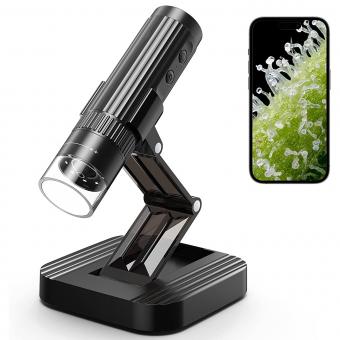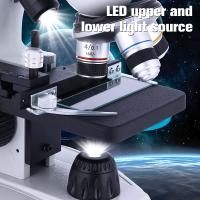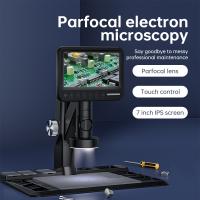How The Microscope Changed The World ?
The invention of the microscope revolutionized the world in numerous ways. It allowed scientists to observe and study the microscopic world, leading to groundbreaking discoveries in various fields. The microscope enabled advancements in medicine by enabling the identification and understanding of microorganisms, leading to the development of vaccines and antibiotics. It also played a crucial role in the field of biology, allowing scientists to study cells, tissues, and organisms at a microscopic level, leading to significant advancements in our understanding of life processes. Additionally, the microscope facilitated advancements in materials science, enabling the study of the structure and properties of materials at a microscopic level, leading to the development of new materials and technologies. Overall, the microscope has had a profound impact on scientific research, medicine, and technology, shaping our understanding of the world and driving progress in various fields.
1、 Advancements in scientific research and discovery
The microscope has undoubtedly revolutionized the world of scientific research and discovery, leading to significant advancements in various fields. Prior to its invention, scientists were limited in their ability to observe and understand the intricate details of the natural world. However, with the advent of the microscope, a whole new realm of exploration opened up, allowing scientists to delve into the microscopic world and uncover a wealth of knowledge.
One of the most significant impacts of the microscope has been in the field of medicine. By enabling scientists and doctors to observe and study cells, tissues, and microorganisms, the microscope has played a crucial role in the development of medical treatments and procedures. It has allowed for the identification and understanding of diseases, leading to the development of vaccines, antibiotics, and other life-saving treatments. Additionally, the microscope has facilitated advancements in surgical techniques, as surgeons can now operate with greater precision and accuracy.
Furthermore, the microscope has been instrumental in the field of biology. It has allowed scientists to study the intricate structures and functions of living organisms, leading to groundbreaking discoveries in genetics, cellular biology, and microbiology. The microscope has enabled the identification of new species, the understanding of evolutionary processes, and the exploration of the complex interactions within ecosystems.
In recent years, technological advancements have further enhanced the capabilities of microscopes. The development of electron microscopes, for example, has allowed scientists to observe even smaller structures with higher resolution. Additionally, the integration of digital imaging and computer analysis has facilitated the sharing and analysis of microscopic data, enabling collaboration and accelerating scientific progress.
In conclusion, the microscope has had a profound impact on the world of scientific research and discovery. Its invention has paved the way for advancements in medicine, biology, and various other fields. As technology continues to evolve, the microscope will undoubtedly continue to play a crucial role in unraveling the mysteries of the microscopic world and driving scientific progress.

2、 Revolutionizing medical diagnostics and treatment
The microscope has undoubtedly revolutionized medical diagnostics and treatment, playing a crucial role in advancing our understanding of diseases and improving patient care. By allowing us to visualize and study the microscopic world, this powerful tool has transformed the field of medicine in numerous ways.
Firstly, the microscope has enabled the identification and characterization of various pathogens, leading to the development of effective treatments and preventive measures. For instance, the discovery of bacteria and their role in causing infections was made possible through the use of microscopes. This knowledge has paved the way for the development of antibiotics, vaccines, and other medical interventions that have saved countless lives.
Furthermore, the microscope has facilitated the diagnosis of diseases by allowing healthcare professionals to examine cells and tissues at a microscopic level. This has led to earlier and more accurate diagnoses, enabling timely interventions and improving patient outcomes. From identifying cancerous cells to detecting infectious agents, the microscope has become an indispensable tool in pathology and clinical laboratories.
In recent years, advancements in microscopy techniques have further enhanced its impact on medical diagnostics and treatment. For example, the development of confocal microscopy and multiphoton microscopy has allowed for non-invasive imaging of living tissues at high resolution. This has opened up new possibilities for studying dynamic processes within the body, such as cell migration and tissue regeneration. Additionally, the integration of microscopy with other technologies, such as molecular imaging and artificial intelligence, has the potential to revolutionize diagnostics and personalized medicine.
In conclusion, the microscope has had a profound impact on the world of medicine by revolutionizing medical diagnostics and treatment. From identifying pathogens to enabling precise diagnoses, this powerful tool has played a crucial role in improving patient care. With ongoing advancements in microscopy techniques, we can expect even greater contributions in the future, leading to further advancements in medical science and ultimately benefiting patients worldwide.

3、 Unveiling the hidden world of microorganisms
The microscope has undoubtedly revolutionized our understanding of the world by unveiling the hidden realm of microorganisms. Prior to the invention of the microscope, these tiny organisms were invisible to the naked eye, leaving scientists and researchers unaware of their existence and significance. However, with the advent of this powerful tool, our perception of the natural world has been forever altered.
The microscope has allowed scientists to observe and study microorganisms, such as bacteria, viruses, and fungi, in great detail. This newfound knowledge has had a profound impact on various fields, including medicine, biology, and environmental science. In medicine, the microscope has enabled the identification and understanding of disease-causing microorganisms, leading to the development of vaccines, antibiotics, and other life-saving treatments. It has also facilitated the study of cellular structures and processes, providing insights into the fundamental mechanisms of life.
Moreover, the microscope has played a crucial role in unraveling the intricate relationships between microorganisms and their environments. It has allowed scientists to explore the diversity and complexity of microbial communities, shedding light on their roles in nutrient cycling, ecosystem functioning, and climate regulation. This knowledge has been instrumental in addressing environmental challenges, such as pollution, climate change, and the preservation of biodiversity.
In recent years, advancements in microscopy techniques have further expanded our understanding of microorganisms. High-resolution imaging, coupled with molecular techniques, has enabled scientists to delve deeper into the hidden world of microorganisms. This has led to the discovery of novel species, the exploration of microbial symbioses, and the understanding of their ecological functions.
In conclusion, the microscope has transformed our perception of the natural world by unveiling the hidden world of microorganisms. Its impact on medicine, biology, and environmental science cannot be overstated. As technology continues to advance, we can expect further revelations and a deeper understanding of the intricate and fascinating world of microorganisms.

4、 Impact on various fields like forensics and materials science
The microscope has undoubtedly revolutionized the world in numerous ways, particularly in the fields of forensics and materials science. Its impact has been profound, enabling scientists and researchers to delve into the microscopic world and uncover intricate details that were previously inaccessible to the naked eye.
In the field of forensics, the microscope has played a crucial role in criminal investigations. By magnifying and analyzing trace evidence such as hair, fibers, and fingerprints, forensic scientists can provide crucial evidence that can link suspects to crime scenes. Microscopic analysis has also been instrumental in identifying and comparing tool marks, bullet striations, and other physical evidence, aiding in the resolution of complex criminal cases.
Similarly, in materials science, the microscope has been instrumental in advancing our understanding of the structure and properties of various materials. By examining materials at the microscopic level, scientists can identify defects, study the behavior of atoms and molecules, and develop new materials with enhanced properties. This has led to significant advancements in fields such as metallurgy, nanotechnology, and semiconductor research.
Moreover, the latest advancements in microscopy techniques have further expanded the capabilities of this powerful tool. For instance, the development of scanning electron microscopy (SEM) and transmission electron microscopy (TEM) has allowed scientists to visualize and manipulate materials at an atomic scale. This has opened up new avenues for research in fields like quantum materials, where the behavior of individual atoms and electrons is of utmost importance.
In conclusion, the microscope has had a profound impact on various fields, particularly forensics and materials science. Its ability to magnify and analyze microscopic details has revolutionized criminal investigations and advanced our understanding of materials at the atomic level. With the continuous advancements in microscopy techniques, we can expect even greater discoveries and breakthroughs in the future.








































